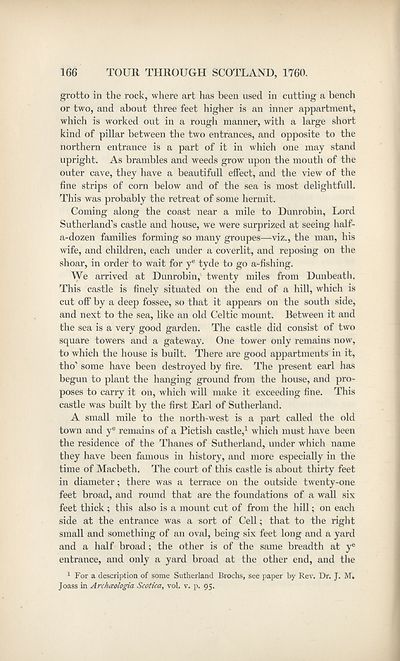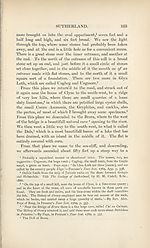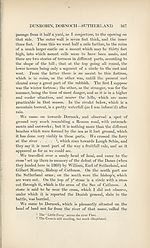Series 1 > Tours in Scotland 1747, 1750, 1760
(253) Page 166
Download files
Complete book:
Individual page:
Thumbnail gallery: Grid view | List view

166
TOUR THROUGH SCOTLAND, 1760.
grotto in the rock, where art has been used in cutting a bench
or two, and about three feet higher is an inner appartment,
which is worked out in a rough manner, with a large short
kind of pillar between the two entrances, and opposite to the
northern entrance is a part of it in which one may stand
upright. As brambles and weeds grow upon the mouth of the
outer cave, they have a beautifull effect, and the view of the
fine strips of corn below and of the sea is most delightfull.
This was probably the retreat of some hermit.
Coming along the coast near a mile to Dunrobin, Lord
Sutherland’s castle and house, we were surprized at seeing half-
a-dozen families forming so many groupes—viz., the man, his
wife, and children, each under a coverlit, and reposing on the
shoar, in order to wait for ye tyde to go a-fishing.
We arrived at Dunrobin, twenty miles from Dunbeath.
This castle is finely situated on the end of a hill, which is
cut off by a deep fossee, so that it appears on the south side,
and next to the sea, like an old Celtic mount. Between it and
the sea is a very good garden. The castle did consist of two
square towers and a gateway. One tower only remains now,
to which the house is built. There are good appartments in it,
tho’ some have been destroyed by fire. The present earl has
begun to plant the hanging ground from the house, and pro¬
poses to carry it on, which will make it exceeding fine. This
castle was built by the first Earl of Sutherland.
A small mile to the north-west is a part called the old
town and ye remains of a Pictish castle,1 which must have been
the residence of the Thanes of Sutherland, under which name
they have been famous in history, and more especially in the
time of Macbeth. The court of this castle is about thirty feet
in diameter; there was a terrace on the outside twenty-one
feet broad, and round that are the foundations of a wall six
feet thick ; this also is a mount cut of from the hill; on each
side at the entrance was a sort of Cell; that to the right
small and something of an oval, being six feet long and a yard
and a half broad; the other is of the same breadth at ye
entrance, and only a yard broad at the other end, and the
1 For a description of some Sutherland Brochs, see paper by Rev. Dr. J. M.
Joass in Arcluzologia Scotica, vol. v. p. 95.
TOUR THROUGH SCOTLAND, 1760.
grotto in the rock, where art has been used in cutting a bench
or two, and about three feet higher is an inner appartment,
which is worked out in a rough manner, with a large short
kind of pillar between the two entrances, and opposite to the
northern entrance is a part of it in which one may stand
upright. As brambles and weeds grow upon the mouth of the
outer cave, they have a beautifull effect, and the view of the
fine strips of corn below and of the sea is most delightfull.
This was probably the retreat of some hermit.
Coming along the coast near a mile to Dunrobin, Lord
Sutherland’s castle and house, we were surprized at seeing half-
a-dozen families forming so many groupes—viz., the man, his
wife, and children, each under a coverlit, and reposing on the
shoar, in order to wait for ye tyde to go a-fishing.
We arrived at Dunrobin, twenty miles from Dunbeath.
This castle is finely situated on the end of a hill, which is
cut off by a deep fossee, so that it appears on the south side,
and next to the sea, like an old Celtic mount. Between it and
the sea is a very good garden. The castle did consist of two
square towers and a gateway. One tower only remains now,
to which the house is built. There are good appartments in it,
tho’ some have been destroyed by fire. The present earl has
begun to plant the hanging ground from the house, and pro¬
poses to carry it on, which will make it exceeding fine. This
castle was built by the first Earl of Sutherland.
A small mile to the north-west is a part called the old
town and ye remains of a Pictish castle,1 which must have been
the residence of the Thanes of Sutherland, under which name
they have been famous in history, and more especially in the
time of Macbeth. The court of this castle is about thirty feet
in diameter; there was a terrace on the outside twenty-one
feet broad, and round that are the foundations of a wall six
feet thick ; this also is a mount cut of from the hill; on each
side at the entrance was a sort of Cell; that to the right
small and something of an oval, being six feet long and a yard
and a half broad; the other is of the same breadth at ye
entrance, and only a yard broad at the other end, and the
1 For a description of some Sutherland Brochs, see paper by Rev. Dr. J. M.
Joass in Arcluzologia Scotica, vol. v. p. 95.
Set display mode to:
![]() Universal Viewer |
Universal Viewer | ![]() Mirador |
Large image | Transcription
Mirador |
Large image | Transcription
Images and transcriptions on this page, including medium image downloads, may be used under the Creative Commons Attribution 4.0 International Licence unless otherwise stated. ![]()
| Scottish History Society volumes > Series 1 > Tours in Scotland 1747, 1750, 1760 > (253) Page 166 |
|---|
| Permanent URL | https://digital.nls.uk/126605793 |
|---|
| Attribution and copyright: |
|
|---|
| Description | Over 180 volumes, published by the Scottish History Society, containing original sources on Scotland's history and people. With a wide range of subjects, the books collectively cover all periods from the 12th to 20th centuries, and reflect changing trends in Scottish history. Sources are accompanied by scholarly interpretation, references and bibliographies. Volumes are usually published annually, and more digitised volumes will be added as they become available. |
|---|


